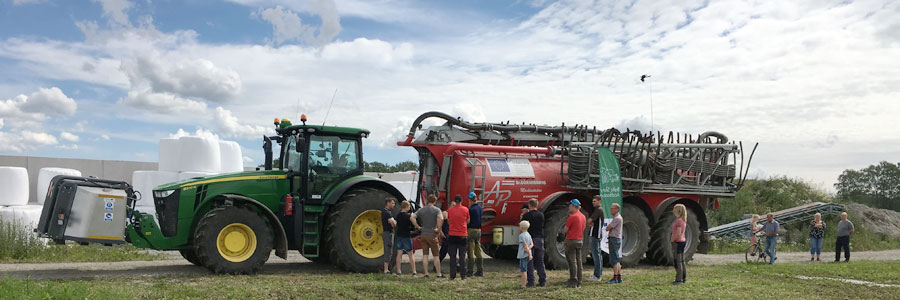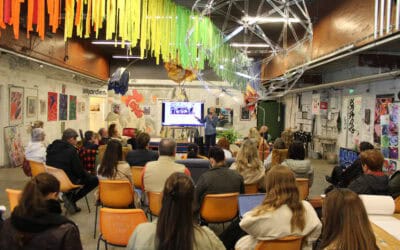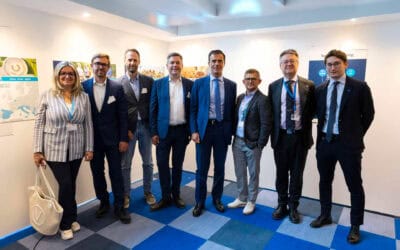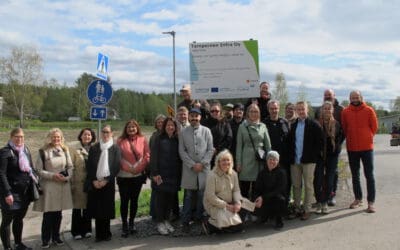By evaporating into the air, ammonia ends up in the sea setting in motion algae growth which exhausts the oxygen and causes other organisms to die. The amounts of ammonia coming from cleaning products may not pose a threat to the environment, however, animal manure does. It is responsible for producing 94% of all ammonia emissions.
Mitigating ammonia emissions together
Ammonia loss from animal manure occurs in animal houses, manure storages and when spreading manure in fields. Various techniques to reduce ammonia emissions are available for farmers. In the Baltic Sea region, among the most common are covering slurry storages and swift cleaning of animal houses. However, a large amount of ammonia is still being released. To stop this, technologies to acidify slurry were developed in Denmark over ten years ago. Slurry acidification means lowering the pH of slurry (the liquid form of pig or cattle manure) before applying it on the fields. This technology was tested by the Danish Environmental Protection Agency and it was proved that this way farms can reduce their ammonia emissions to 36%. Although these acidification techniques are accepted as the best available technology to manage emissions, it is hardly used outside Denmark. As Kaj Granholm, from the Baltic Sea Action Group, puts it: “just to rely on Danish experience is not enough to convince the national agricultural actors to use the technology and make European wide decisions on its application. We need to look more specifically to find the right ways to apply, regulate, subsidise acidification techniques. We need experiences from different contexts: different types of farming systems, soils, manure”. By coming together, partners from Sweden, Finland, Estonia, Latvia, Lithuania, Poland, Germany and Denmark, representing agriculture industry, are pooling new ideas and resources to introduce and implement the slurry acidification technologies throughout the Baltic Sea region.
Video: Understand why ammonia is a problem and how slurry acidification can reduce it.
Research and experiments were carried out by project partners around the Baltic Sea comparing acidified slurry with raw slurry and mineral fertilisers. Regarding ammonia emissions, crop yield, plant health, and soil pH, it was proved that using acidified slurry in farms provides a triple benefit.
First, it significantly reduces ammonia emissions into the air, which reduces risks on both the environment (eutrophication) and human health. Acid changes the chemistry by transforming ammonia in the slurry into ammonium-nitrogen. It is a salt which is absorbed by plants. This means that the nitrogen which would otherwise be lost in the air, is saved and used by the plants. “Nitrogen losses are reduced twice if slurry is acidified. In soil with higher pH, acidified slurry even helps to eradicate plant diseases such as septoriosis”, explains Rimas Magyla, the head of department of technology services at LAAS, Lithuania.
In other words, a larger share of the nitrogen in the slurry is converted to a form similar to that in mineral fertilizers which thus makes slurry a viable alternative to mineral fertilizers. This is the second benefit of slurry acidification: farmers can stock up organic matter in the soil coincidentally with fertilization in a sustainable way.
Thirdly, when acidifying slurry with sulphuric acid, the fields get the necessary dosage of sulphur, thus saving the farmer the additional cost of separate sulphur fertilizer. Sulphur is the fourth macro-nutrient (along with nitrogen, phosphorus and potassium) and vital for plants’ health and growth. In addition, leaf diseases were proved to be reduced in Estonia when using acidified slurry from pigs, while in Poland it improved the general quality of plants.
Video: Hear the project partners explain what they did, what they achieved and what they gained from the Baltic Slurry Acidification project for their regions.
Continuing to save the Baltic Sea
Even though ammonia is an inevitable by-product of animal production, the project proves that ammonia emissions can be cut by good management. The Baltic Slurry Acidification project has created international and national expert and multi-stakeholder networks to further look into the specifics in implementing the technologies. The networks and the new project platform SuMaNu (“Sustainable manure and nutrient management for reduction of nutrient loss in the Baltic Sea Region”) continue to share experiences, communicate the results and new findings and enhance capacities for cleaner farming and environment.
Story by Rūta Kaminskaitė based on an interview by Stefanie Maack with Kaj Granholm, Baltic Sea Action Group







